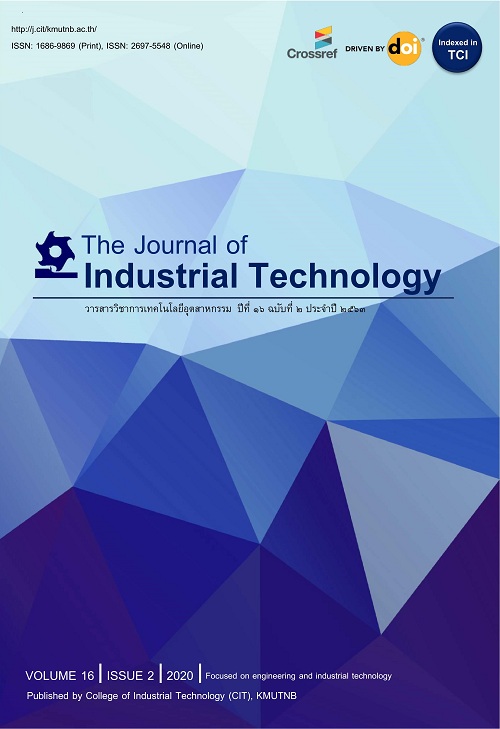การใช้กากแคลเซียมคาร์ไบด์ผสมเถ้าถ่านหินเป็นวัสดุประสาน เพื่อทำคอนกรีตที่มีความสามารถในการเทสูง
Use of Calcium Carbide Residue-Fly ash as Binder to Produce High Workability Concrete
Abstract
บทคัดย่อ
งานวิจัยนี้ใช้กากแคลเซียมคาร์ไบด์ผสมเถ้าถ่านหินเป็นวัสดุประสานแทนการใช้ปูนซีเมนต์ในการผลิตคอนกรีตที่มีคุณสมบัติในการเทสูง วัสดุประสานทำจากส่วนผสมของกากแคลเซียมคาร์ไบด์บดกับเถ้าถ่านหินไม่บด (CR-OF) และกากแคลเซียมคาร์ไบด์บดกับเถ้าถ่านหินบด (CR-FA) ในอัตราส่วนร้อยละ 30 ต่อ 70 โดยน้ำหนัก ตามลำดับ นอกจากนี้ใช้ปูนซีเมนต์เป็นสารเร่งกำลังแทนที่วัสดุประสานในส่วนผสม CR-FA ที่อัตราส่วนร้อยละ 10 โดยน้ำหนักของวัสดุประสาน (CR-FA(10)) ทดสอบค่าการยุบตัวแบบแผ่ของคอนกรีตสด โดยควบคุมค่าการยุบตัวแบบแผ่ให้อยู่ในช่วง 600 ถึง 800 มิลลิเมตร และทดสอบการสูญเสียค่ายุบตัวของคอนกรีต ทำการหล่อก้อนตัวอย่างคอนกรีตทรงกระบอกขนาดเส้นผ่านศูนย์กลาง 10 ซม. สูง 20 ซม. โดยไม่มีการจี้หรือเขย่าใดๆ เพื่อทดสอบกำลังอัดของคอนกรีตที่อายุ 3, 7, 28, 60 และ 90 วัน ผลการวิจัยพบว่า กากแคลเซียมคาร์ไบด์บดผสมเถ้าถ่านหินทั้งที่ไม่บดและบดสามารถนำมาใช้เป็นวัสดุประสานเพื่อผลิตคอนกรีตที่มีคุณสมบัติในการเทสูงได้ โดยค่าการยุบตัวแบบแผ่ของคอนกรีตสดมีขนาดเส้นผ่านศูนย์กลางอยู่ในช่วงเท่ากับ 740 ถึง 760 มม. นอกจากนี้คอนกรีต CR-OF, CR-FA และ CR-FA(10) มีค่าการยุบตัวแบบแผ่ที่สูงกว่าคอนกรีตที่ใช้ปูนซีเมนต์ปอร์ตแลนด์เป็นวัสดุประสาน และยังมีการสูญเสียค่ายุบตัวที่น้อยกว่าด้วย คอนกรีต CR-OF และ CR-FA ให้ค่ากำลังอัดเท่ากับ 153 และ 225 กก./ซม.2 ที่อายุ 90 วัน ตามลำดับ แม้ว่าวัสดุประสานดังกล่าวไม่ใช้ปูนซีเมนต์ปอร์ตแลนด์ การใช้เถ้าถ่านหินที่มีความละเอียดสูงและการใช้ปูนซีเมนต์เป็นสารเร่งกำลังสามารถพัฒนากำลังอัดของคอนกรีตให้สูงขึ้นได้ โดยคอนกรีต CR-FA(10) ให้ค่ากำลังอัด เท่ากับ 210 และ 252 กก./ซม.2 ที่อายุ 28 และ 90 วัน ตามลำดับ แม้ว่าคอนกรีตไม่มีการจี้หรือเขย่าใดๆ
Abstract
This research aims to use calcium carbide residue and fly ash mixture as a binder instead of using Portland cement in order to produce high workability concrete. The binder used a ratio of 30:70 by weight for ground calcium carbide residue and both original and ground fly ash, CR-OF and CR-FA, respectively. In addition, Portland cement Type I (OPC) was used as strength accelerator at a ratio of 10 percent by weight of the binder, CR-FA(10). The slump flow of all fresh concrete mixtures was determined, and was maintained between 600 to 800 mm. Furthermore, the slump loss of concrete was also determined. The cylindrical concrete specimens, 100 mm in diameter and 200 mm in height, were cast and no required vibration for placing and compaction. The compressive strengths of the concrete were tested at the ages of 3, 7, 28, 60 and 90 days. The results indicated that the calcium carbide residual and fly ash mixture could be used as a binder to produce high workability concrete with slump flow between 740 to 760 mm. In addition, CR-OF, CR-FA, and CR-FA(10) concretes had slump flow higher, and had slump loss lower than that of normal concrete which using Portland cement. The CR-OF and CR-FA concretes gave the compressive strengths of 153 and 225 ksc at 90 days although the binder without using Portland cement, respectively. The use of high fineness of fly ash and OPC strength accelerator can enhance compressive strength gain for calcium carbide residue-fly ash concrete. Although the concrete no required vibration for placing and compaction, the CR-FA(10) concrete had compressive strengths of 210 and 252 ksc at 28 and 90 days, respectively.
Keywords
Refbacks
- There are currently no refbacks.






